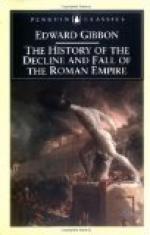|
This section contains 6,305 words (approx. 22 pages at 300 words per page) |

|
SOURCE: Brownley, Martine Watson. “Gibbon's Artistic and Historical Scope in the Decline and Fall.” Journal of the History of Ideas 42, no. 2 (October-December 1981): 629-42.
In the following essay, Brownley argues that one reason the Decline and Fall is still read today is because of limitations in Gibbon's imagination and philosophical abilities, limitations that, paradoxically, have kept his historical work from becoming merely a window to eighteenth-century scholarship.
Much of the effectiveness of The Decline and Fall of the Roman Empire derives from Edward Gibbon's ability to create a vast scope for his subject extending well beyond the ostensible historical limits of the centuries from the Age of the Antonines to the fall of Constantinople. He achieves this expanded scope in his history not only by including material outside the strict confines of his topic but also by effectively juxtaposing comparable and disparate events and figures comprehended within this enlarged...
|
This section contains 6,305 words (approx. 22 pages at 300 words per page) |

|


